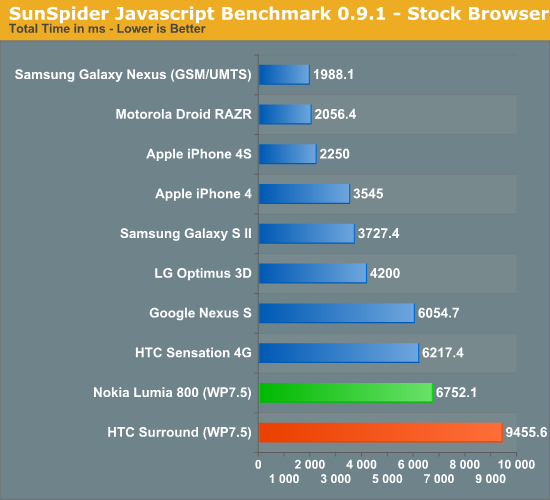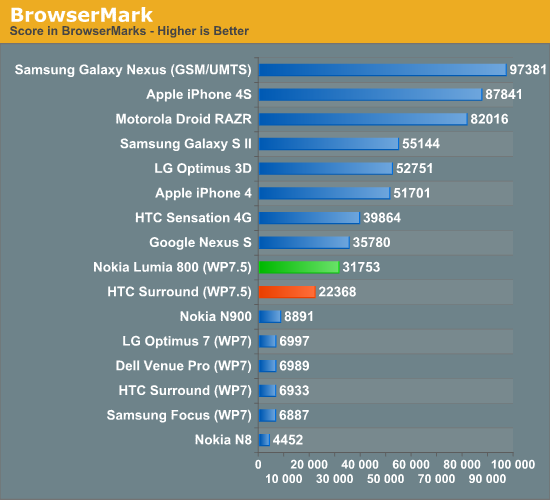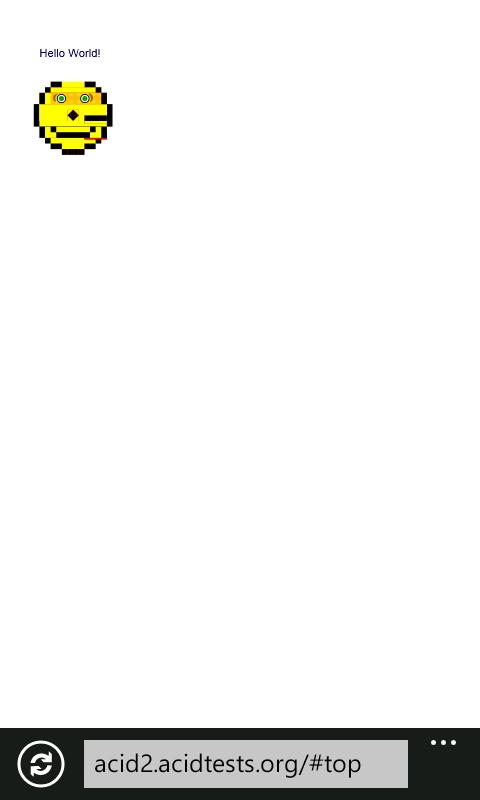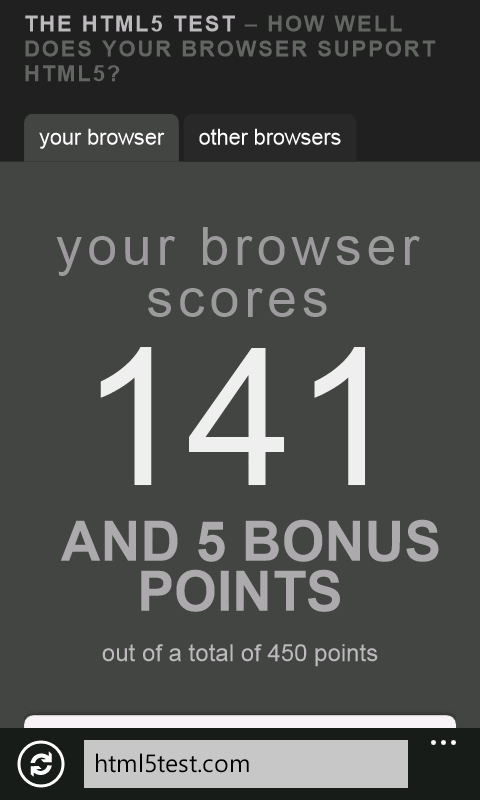Nokia Lumia 800 Review - Nokia's Brave New Foray into WP7
by Brian Klug on January 4, 2012 7:00 AM EST- Posted in
- Smartphones
- Nokia
- windows phone 7
- Mobile
- WP7
- Lumia
- Lumia 800
Unfortunately, the majority of benchmarks that usually grace our smartphone reviews don’t yet have WP7 ports or analogs, but there are a still a number of comparisons we can make. To start, the browser-based performance metrics give a good picture within the Windows Phone ecosystem, and likewise with WPbench, created by one of our own readers and on the marketplace.
There’s been a lot written about performance on WP7 already - namely that comparative analysis isn’t as big of a deal as it is on other smartphone platforms, but of course this is more the result of two things. First, Microsoft’s careful curation of their new smartphone platform with hardware requirements; second, availability of native and managed code execution environments. For the most part, you can pick up any WP7 device and have very good expectation of UI smoothness, but that’s not to say there aren’t differences, especially as the platform moves from one generation of Snapdragon SoC to the next, and now possibly even a move to ST-E. Benchmarking WP7 (and by analog, Windows 8) will become a big deal very soon, however, and numerous SoC vendors and big names in the PC benchmarking scene are looking to port to these platforms.
This current refresh of WP7 devices continues to be based around exclusively Qualcomm SoCs, and the Lumias are no exception. Both the 710 and 800 are based around Qualcomm’s MSM8255 single core S2 Snapdragon at 1.4 GHz with Adreno 205 graphics at the core and dual channel LPDDR2 memory interfaces. This is a 45nm part we’ve seen and explored numerous times before, and as a refresher includes the HSPA+ 14.4 baseband onboard.
Anyhow, onward to the numbers. First is sunspider, which we’ve been using for a long while and recently changed from 0.9 to 0.9.1 with. As a result, I’ve had to re-run devices since the numbers aren’t directly comparable. WP7.5 brings a much improved javascript engine which gives it a big boost in scores. I’ve managed to hang onto the HTC Surround (1.0 GHz QSD8250) and Anand has the Focus (also 1.0 GHz QSD8250), which we’ve included as well.

Browsermark hasn’t changed or forced us to re-run things, so we have comparison numbers that show how much difference there is in the browser department in WP7.5.

In the synthetics, WP7.5’s new JavaScript engine (Chakra) with JIT brings perf almost up to modern levels and is a step in the right direction, but it’s still behind iOS and Android. Moving to a higher clocked single core probably does make sense for Windows Phone, especially if IE is single threaded at this point.
For system benchmarking on WP7.5 we have WP Bench, which was created by one of our own readers. The benchmark reports a total score in addition to three sub-scores for CPU, memory, and GPU. My only point of comparison, again, is the HTC Surround.
| WPBench Comparison | ||
| HTC Surround (1.0 GHz QSD8250) | Nokia Lumia 800 (1.4 GHz MSM8255) | |
| Total Score | 59.85 | 91.14 |
| Result Screenshot |
|
|
Browser Performance and Changes
I’ve made a big deal about browsing performance because, for me at least, the stock browser is the one place where performance really must be flawless. OEMs are starting to wake up to the fact that browsing performance makes a huge impact on the overall subjective weighting of a platform’s smoothness, which in turn results in a lot of scrutiny. I’d agree with this assertion as well and toss in a few other things that must be flawless for a platform to feel speedy.
When WP7.5 first started surfacing we took a look at its revamped IE9-based browser which uses Trident 5.0 as opposed to NoDo’s Trident 3.1. Unsurprisingly everything we saw in the emulator applies to the real-world experience with WP7.5 on live devices. Actually things are even a bit better than they were when we played around in the emulator.


The Windows Phone team has made clear several times that they aren’t going to build the browser to any tests but instead real-world page rendering accuracy. That said it’s still worthwhile to take a look at the synthetics. Acid 3 now completes and nearly passes (the boxes in top right subtract some points) where it previously scored below 95. Similarly Acid 2 now is almost flawless. Finally, the HTML5test score increases from 130 to 141 on the Lumia 800 and newer WP7.5 builds, which is a slight but still important difference.

Moving away from Trident 3.1 to 5.0 has made a huge difference on faithful page rendering and eliminated nearly all of the annoying edge cases I saw with previous WP7 smartphones. A number of pages I visit daily back when we did those reviews would render but with a few notable errata, these are now gone completely.
In addition, scrolling performance remains just as speedy as it was before (essentially buttery smooth) as the rendering architecture remains largely the same. We now have all three platforms (WP7.5, iOS, and Android 3.x/4.x) rendering the browser page into a texture that can be translated, clipped, and zoomed with GPU operations. It’s clear that this is the right way to do things to keep the browser UI speedy.
The changes to WP7.5’s browser make (for me at least) the single most notable improvement over NoDo and previous iterations. It’s a huge step forwards in rendering, compliance, and UI, and having that browser experience be as close to perfect as possible is tremendously important.












120 Comments
View All Comments
Iketh - Wednesday, January 4, 2012 - link
Look, you either write it the way I suggested above using series, or "There's a lot riding on Lumia devices, which are Nokia's first to run Windows Phone 7.5."Either way, doesn't matter.
BioTurboNick - Thursday, January 5, 2012 - link
Except that "which" proxies for "Lumia series" not "first devices".Better construction would be "Lumia series of devices, which are..." or "Lumia series, which is Nokia's first line of devices."
BioTurboNick - Thursday, January 5, 2012 - link
I take that first one back. The subject would still be the series, not the devices.Brian Klug - Wednesday, January 4, 2012 - link
Apologies, these are all fixed now :)-Brian
Iketh - Wednesday, January 4, 2012 - link
Thx, feel free to delete this thread. I'm not making these posts in the future.465thGTG - Wednesday, January 4, 2012 - link
I guess not since you demand $100 for advise like that.james.jwb - Thursday, January 5, 2012 - link
Advice :)sprockkets - Thursday, January 5, 2012 - link
Yeah, **** this site. After 12 years of reading excellent review I read no more site due to grammer (sic).Dude, **** yourself.
Starfireaw11 - Wednesday, January 4, 2012 - link
I'd been wanting to ditch my iPhone 3GS and switch over to a Windows Phone ever since WP7 launched. The problem was that the hardware that was available just plain sucked. It was like the manufacturers weren't even trying. When Nokia announced that they were going to develop WP7 devices, I figured that I would hang on to the iPhone a little longer and wait and see what they could come up with as I'd always loved the build quality of Nokia phones, even my mid '90s brick. Fortunately in the meantime, Microsoft released WP7.5, which fixed a number of issues that were a down side to the WP7 devices, which was a real plus.When the Lumia 800 finally dropped in the UK, there were no announcements of it being released anywhere else, and I wanted one pretty badly. I ordered one online from a UK carrier and had it shipped to Australia. In the meantime, I contacted my provider and ordered a Micro SIM for it.
I've had the device for about a month now and I have to agree with everything that has been said in this article - I'm really happy with it and it's a huge improvement over the iOS, the build quality is fantastic and it's got a great "feel" to it when using the hardware. I give it an honest 8.5 / 10 and feel the need to point out that the fact that it doesn't get a 9 or 9.5 are all software related (as in the battery issues mentioned, as well as deficiencies in the WP7.5 OS and Zune software).
It's a really great product and if you're sick of iOS and Android devices or if you want to try something different, you should definately give it a go!
N4g4rok - Wednesday, January 4, 2012 - link
I've never been able to agree with the poor hardware specs argument mainly because mobile operating systems differ so much in requirements.A dual core processor on an Android device makes sense because it almost eliminates some of the slowdowns you get with bloated applications or the OS itself. Apple's A5 is tailored to fit their device specifically, so we know the requirements aren't even a negotiable issue.
I don't think WP7 requires as many resources as smartphone advertising has led us to believe. Personally, i've yet to see one get seriously hung up on a 1 Ghz SoC. Even though i can see why developers themselves would be interested in powerful hardware, i think powerhouse applications really fit into a small niche of smartphone use.